Smith on Wry: Jack Smith, Columnist for Our Times

Jack Smith, ca. 1925. Born in Long Beach in 1916, Jack Smith grew up in Whittier, Bakersfield, and Los Angeles. He began working as a sports reporter for the Bakersfield Californian in the late 1930s and moved on to the Honolulu Advertiser. After World War II, he worked for the Los Angeles Daily News, joining the Los Angeles Times as a reporter in 1953 and becoming a columnist five years later.
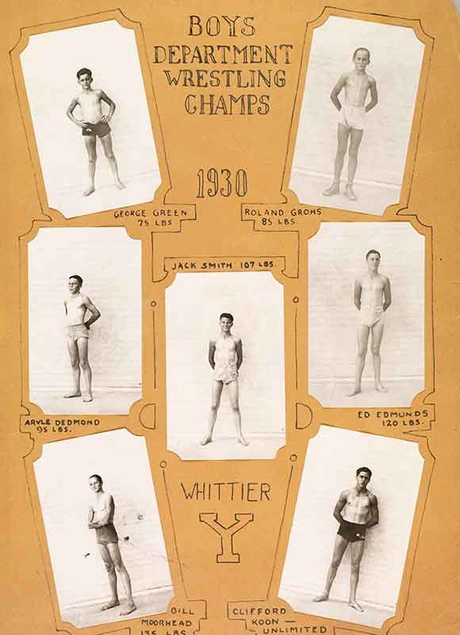
Whittier YMCA. Boys' Department Wrestling Champs, 1930. Smith also played on the YMCA's midget basketball team, which, like the wrestlers, had winning seasons. The Whittier YMCA boys beat teams from Long Beach, Los Angeles, Huntington Park, Los Nietos, and Pico (the city later merged with Rivera to become Pico Rivera). Later, at Belmont High School, Smith was the high-point man one season, scoring forty-six for the lightweight basketball team. Jack Smith's photograph is in the center of the page.
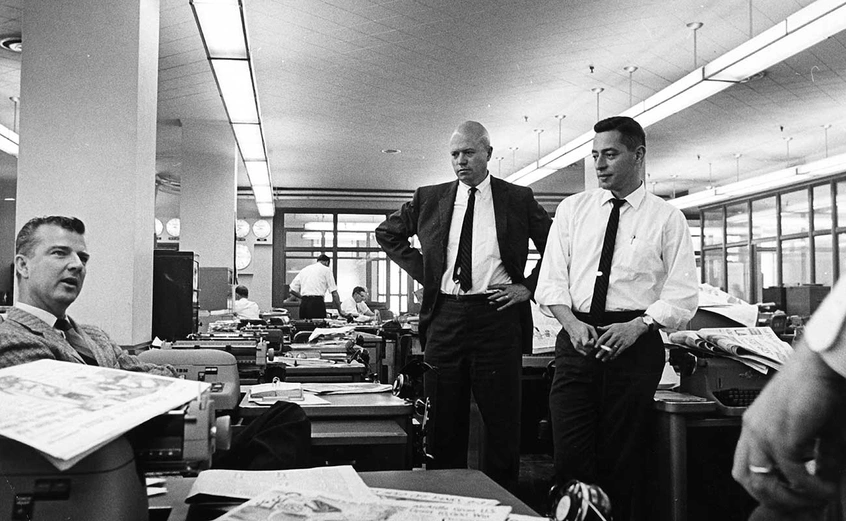
Jack Smith in the newsroom of the Los Angeles Daily News, ca. 1948. During the late 1940s and early 1950s, Smith worked as a reporter and rewrite man, whose job is to receive telephone reports from journalists in the field and turn them into a news story. Westways, the magazine of the Automobile Club of Southern California, published this photograph in its December 1974 issue, with the caption "Fastest rewrite man in the West." A reader, Anita Stutley of Los Angeles, wrote to ask Smith if he still had the socks and tie.
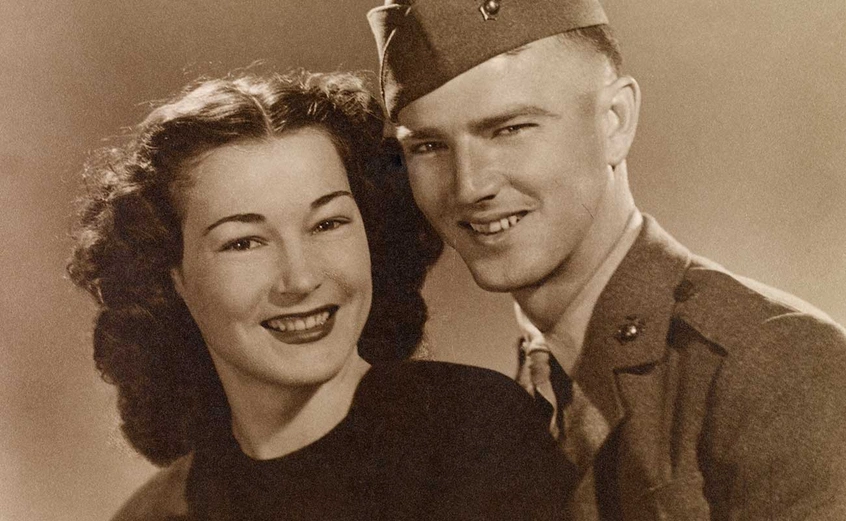
Photograph of Jack and Denny Smith, 1945.
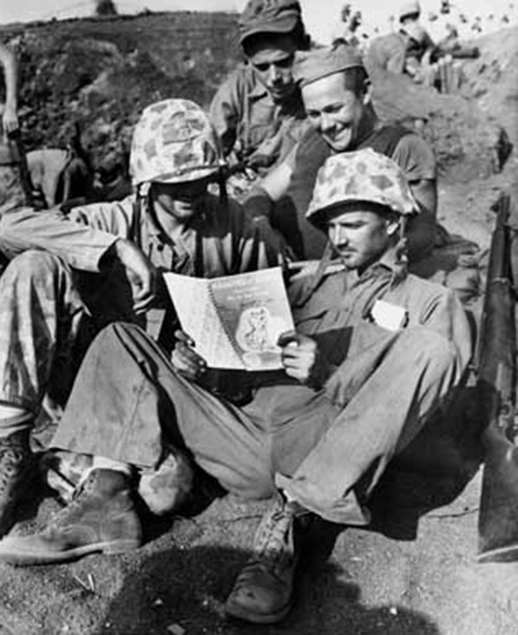
U.S. Coast Guard. Photograph of Jack Smith and fellow Marines, March, 1945. Resting on the beachhead at Iwo Jima, Smith consulted a handy book called Naming Your Baby. In letters to Denny, he suggested such names as Lucky Jordan Smith (after the title character in the 1942 Alan Ladd film) and Caesar Wolfgang Smith. However, in one postscript, he allowed that he liked the name Curt "better every minute."
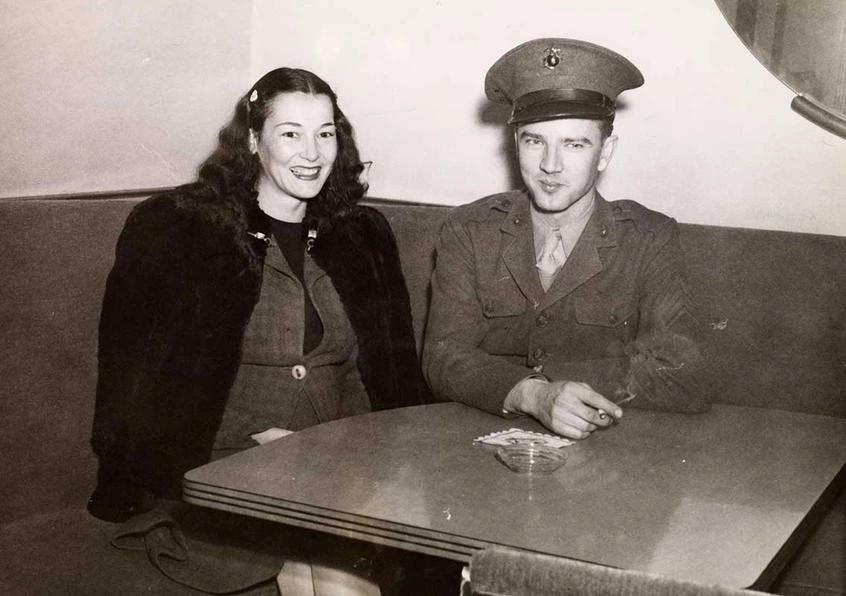
Jack and Denny Smith, at the Techau Cocktail Lounge, San Francisco, January or February 1945. Jack Smith married Denise Bresson (called Denny) in 1939. At the time of this photograph, taken before Jack shipped out for Iwo Jima, Denny was expecting their first child.
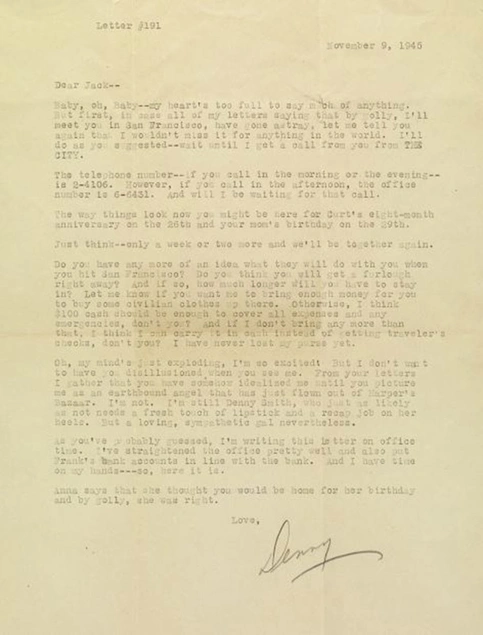
Denny Smith. Letter to Jack Smith, November 9, 1945. For months after the end of the war, soldiers impatiently awaited discharge from the military, and so did their families. In this letter, Denny responds to learning that Jack will soon come home. He received his discharge from the marines on February 5, 1946. Read the letter.

U.S. Marine Corps. Certificate of Honorable and Satisfactory Service for Jack Smith, February 5, 1946.
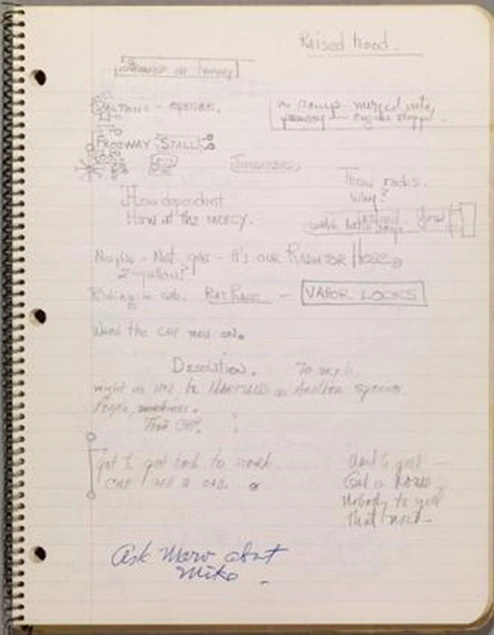
Jack Smith. Notebook, undated. This is one of many notebooks in which Smith jotted down notes ranging from ideas for columns to favorite quotations to phone numbers and names of contacts for interviews. On this page, he records some random thoughts about driving and freeways – topics that are never far from the minds of Angelenos.

Romulo Gomez and Jack Smith working on the house, ca. 1970.
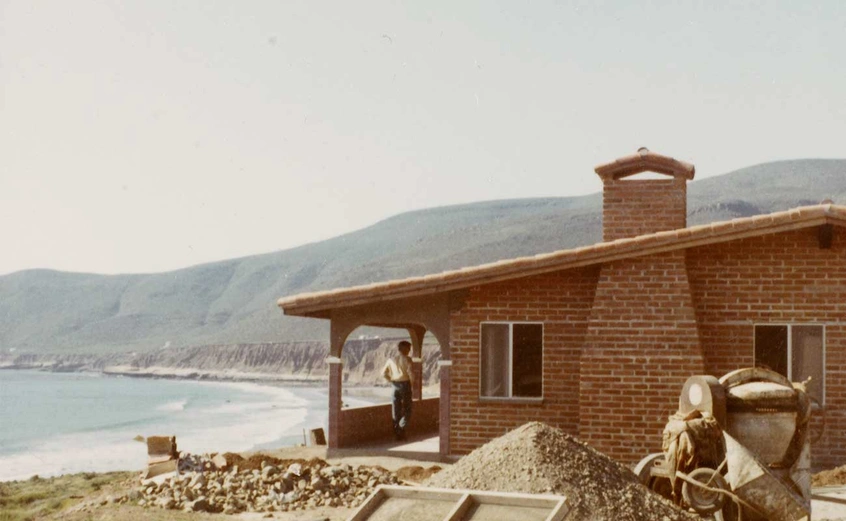
The Smith house in Santo Tomas, Baja, ca. 1970.
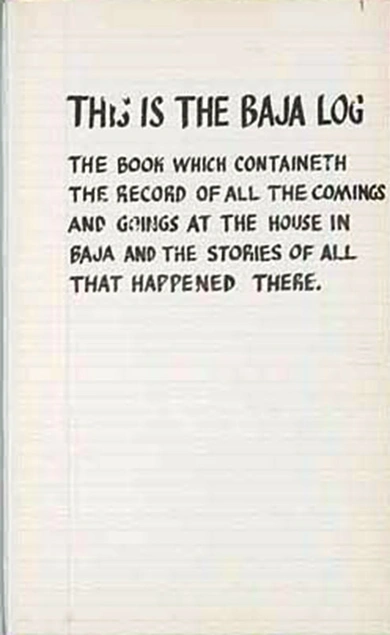
Jack Smith. Baja Logbook, 1970-1977. Smith's journal of life in Baja is open to the first page, with the entry for May 16, 1970, the first day of occupancy. The entry recounts various glitches in the house, especially the crossed lines that sent hot water through the pipes to the toilet. In his July 8, 1990, column about the end of the Baja days, "Adios to Gomez and Their Baja Mansion," Jack wrote more about their first stay in the house: "I had always told him that I would not consider the house finished until the toilet was in. He called us from Tijuana one day and told us the house was finished. The toilet was in. We rushed down to La Bocana and threw upon our front door. The toilet was sitting in the living room."

Jack Smith's Greek fisherman's hat. Courtesy of Curtis B. Smith.
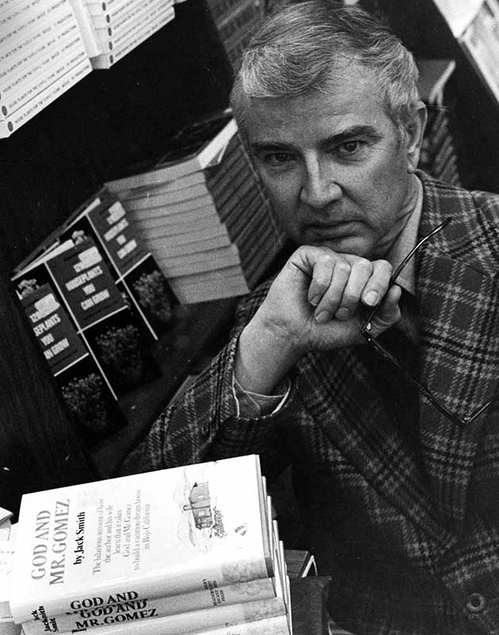
Jack Smith at a book signing "God and Mr. Gomez", 1974.
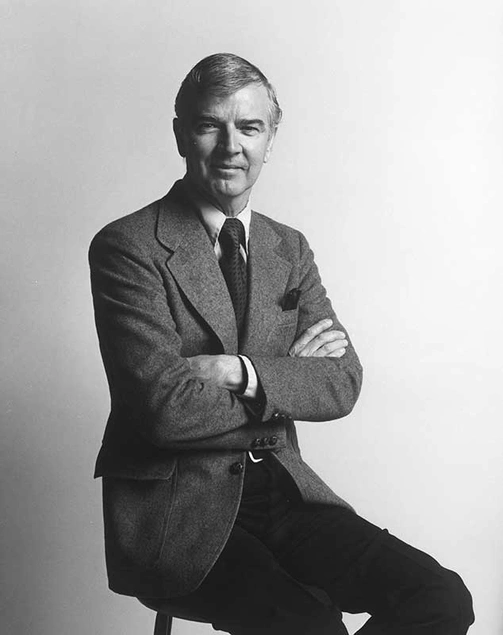
Portrait of Jack Smith, ca. 1975.

Jack Smith. Floppy disks and a miniature data cartridge. When Jack Smith replaced his typewriter with a computer, he not only entered a new technological age, but he realized that the computer and related technologies would change life profoundly and permanently. He was especially fascinated and alarmed that the advent of the computer would mean the eventual demise of corrected literary drafts. As authors turn increasingly to writing novels, poetry, and plays at the computer, scholars will be unable to study the development of writers' texts. Smith himself became an example of his prediction. From the mid-1980s, when he adopted the computer, his writings are chiefly on disks, rather than paper texts showing corrections. As a result, many of his edits and corrections are gone. Moreover, his files, many in obsolete digital form, must be recovered electronically in order to be read and preserved.
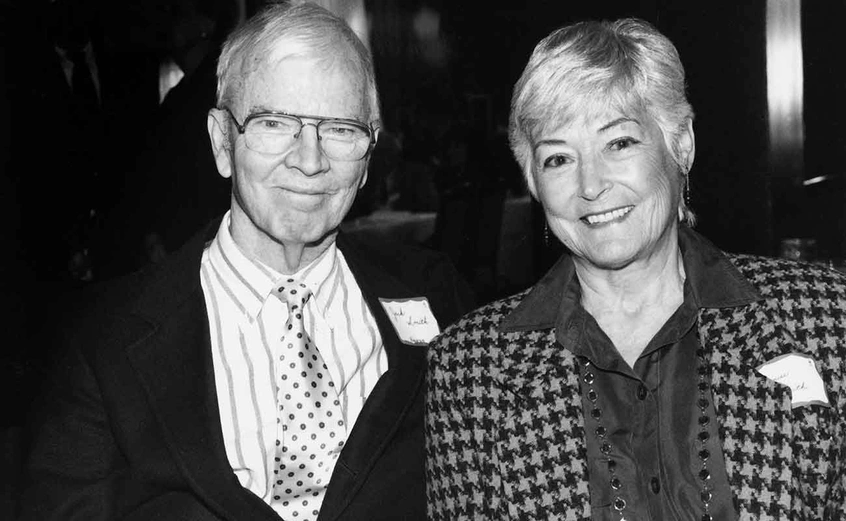
Jack and Denny Smith, at the Historical Society of Southern California, ca. 1990.
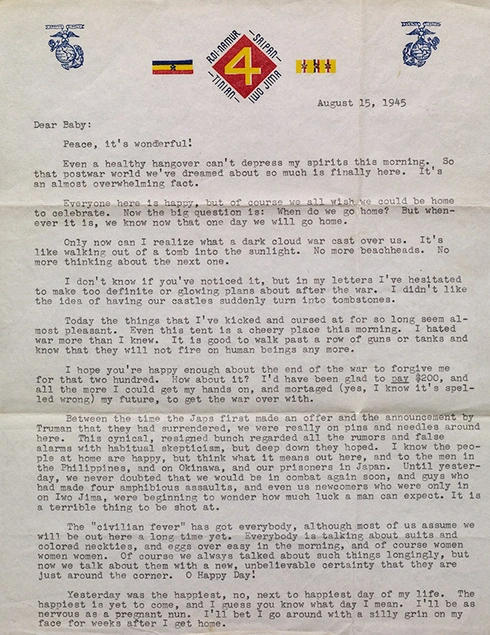
Jack Smith. Letter to Denny Smith, August 15, 1945. August 15, 1945, was the official date of victory over Japan, and Smith writes in jubilation about the end of a long and wearying war. The Japanese surrendered on September 2 in a ceremony on board the U.S.S. Missouri.
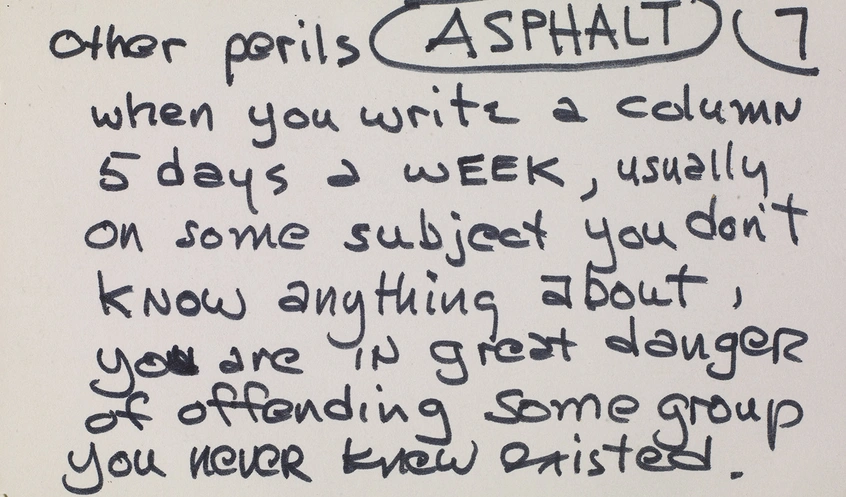
Jack Smith. Note card, undated. Smith notes the ease with which a regular columnist manages inadvertently to offend groups he never knew existed.
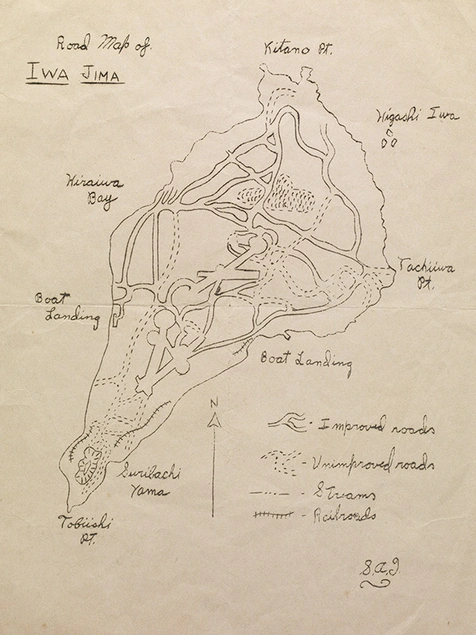
Map of Iwo Jima, 1945. Over the years that Jack Smith wrote his newspaper column, many former soldiers, sailors and marines wrote to him, recalling their wartime experiences and sending mementos. In a letter to Smith dated September 5, 1981, John McKinney enclosed this map of the island of Iwo Jima that had been distributed to the marines on board his ship, the Hanford, prior to landing.
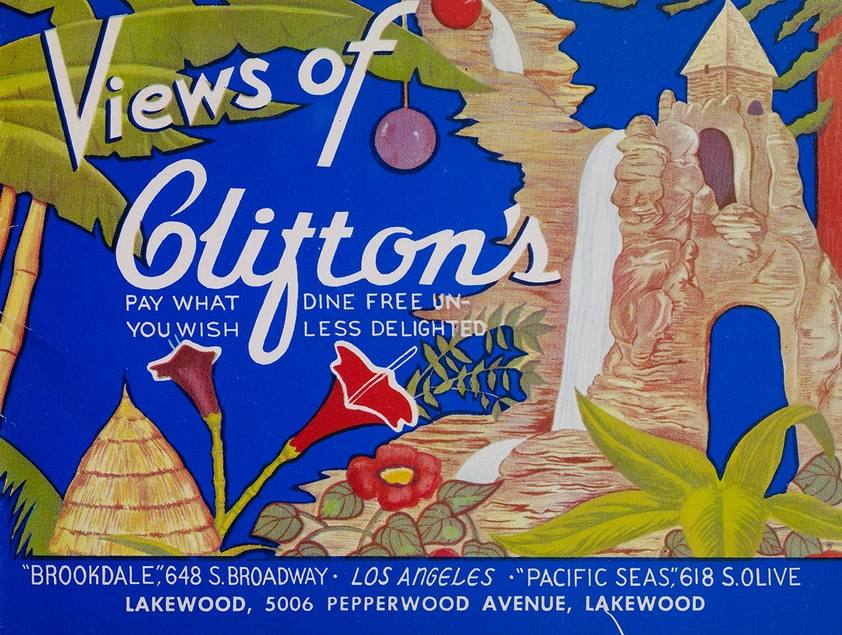
Views of Clifton's, promotional booklet, 1956. A favorite landmark of Los Angeles since 1931, Clifton's Cafeteria featured a South Seas décor and singing waiters and waitresses. The original Clifton's Pacific Seas closed in 1960, but the second restaurant, Clifton's Brookdale, which opened in 1935, is still operating.

International Flat Earth Society of America. Card awarding Jack Smith an honorary membership, undated.
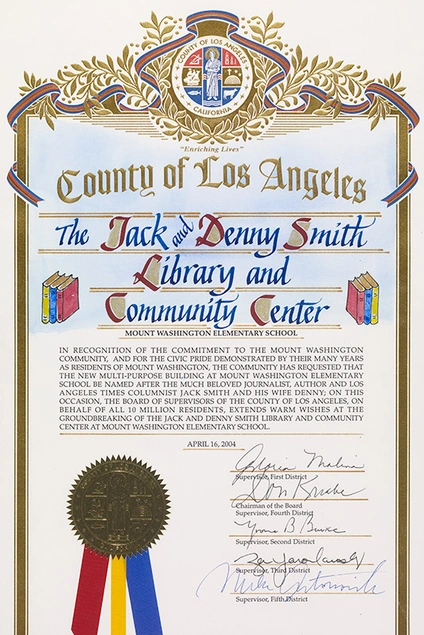
County of Los Angeles, Board of Supervisors. Proclamation recognizing the dedication of the Jack and Denny Smith Library and Community Center, April 16, 2004. The proclamation is signed by supervisors Gloria Molina, Don Knabe, Yvonne Braithwaite Burke, Zev Yaroslavsky, and Mike Antonovich.
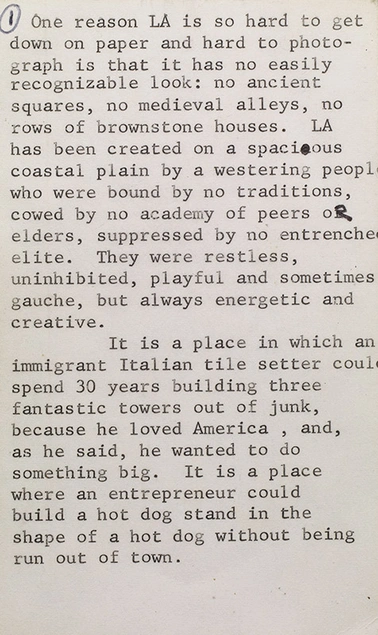
Jack Smith. Notecard, undated. This item is from Smith's extensive file of cards containing notes on topics of interest. It explores Smith's thoughts about the physical spaces and landmarks of Los Angeles, and how those features exert their influence on the city's inhabitants. He writes that the lack of a recognizable look makes L.A. hard to characterize or photograph, but that the open spaces of the city, make for a freer, more tolerant way of life than might be found in other cities.

Jack Smith. Commencement address for Occidental College, corrected typescript, June 9, 1979. Smith was a frequent graduation speaker at area schools. For Occidental College, he spoke about Los Angeles, and his typescript includes his markings for emphasis in delivering the address.

Jack Smith. Note card on Fleetwood Pugsley. Smith created scores of note cards, both typed and handwritten, recording a variety of ideas and quotations, anything that could be used in future writing. Here, he writes a fond, posthumous memory of Pugsley.
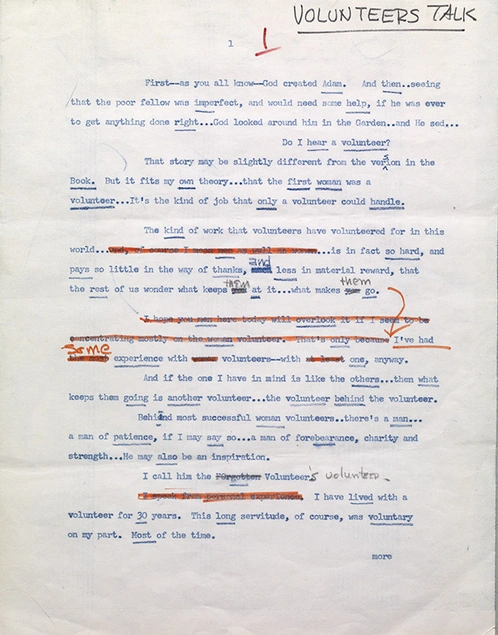
Jack Smith. Untitled speech about volunteerism, corrected typescript, undated. Smith's speech pays humorous tribute to women who volunteer, especially his wife, Denny, and to the men who stand behind them. His typescript is marked for presentation.

The Smith family, ca. 1958. Doug, Curt, Jack and Denny, with their faithful companion Gene Biscailuz.
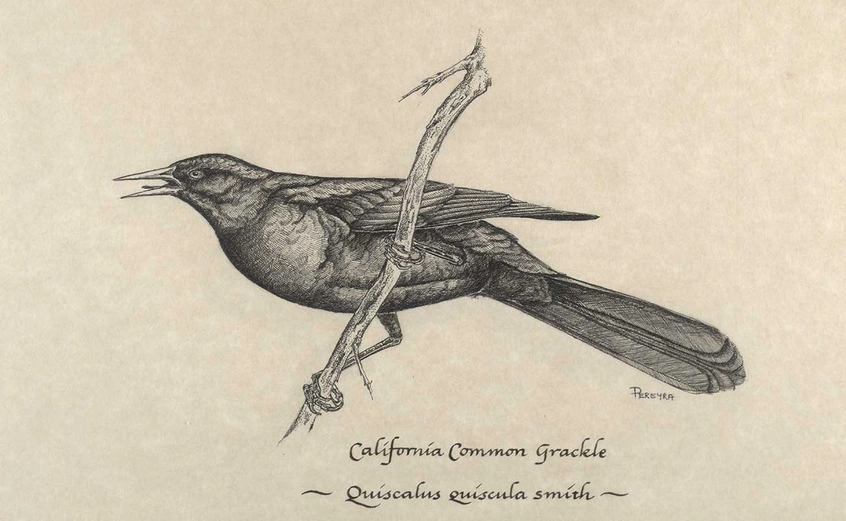
Mary Ellen Pereyra. Note cards depicting the California Common Grackle, presented by the Los Angeles Audubon Society, January 12, 1976. Grackle mementos and art perched throughout the Smith home, as well as in Jack Smith's files. In this example, the Latin genus and species on the card, Quiscalus quiscula smith, honors Jack Smith as the first to sight the grackle in California.
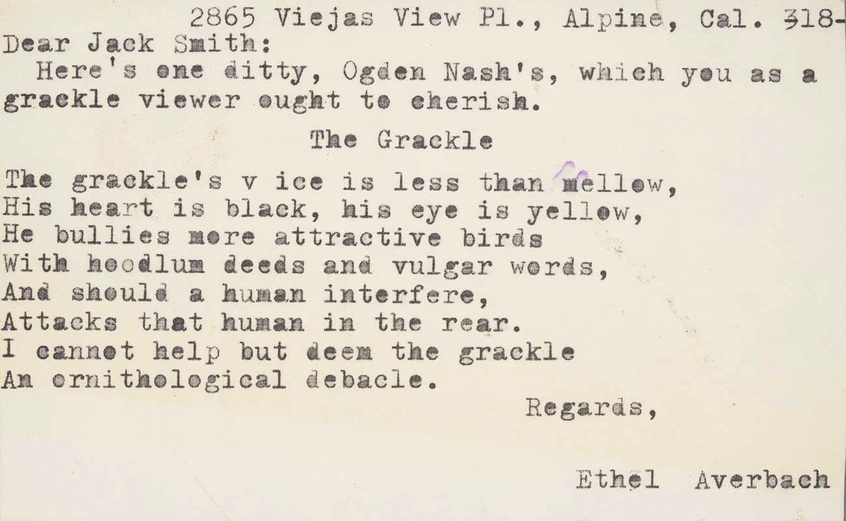
Ethel Averbach. Postcard to Jack Smith, March 19, 1973. Smith's grackle sighting claim and his resulting columns led to scores of letters from his readers, who were captivated by the controversy. In this postcard, a reader sends him Ogden Nash's poem, "The Grackle."
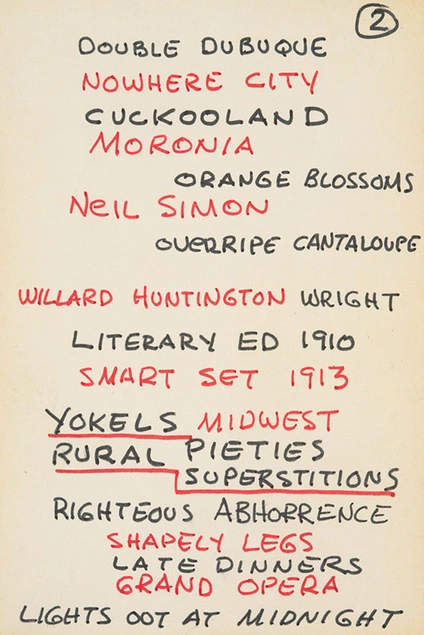
Jack Smith. Note card, undated. In this card from his extensive set of notes, Smith listed several of the nicknames that critics gave to Los Angeles over the years. Smith's abiding affection for his city and its way of life infused his columns with their sense of place and made him the voice of L.A. As he wrote in a column titled "He'll Continue to Be the Best That He Can Be," dated December 23, 1991: "I have often been asked, 'What is your column about?' My answer is that it is about being me and living in Los Angeles. Consequently, I hoped, it would be about everybody who lives in Los Angeles."

Jack Smith. "Spend All Your Kisses," printed with movable type on linen, undated but after 1977. Courtesy of Alison P. Smith.
Jack Smith created this wall hanging with one of his favorite sayings, using type pieces given to him by Denny.
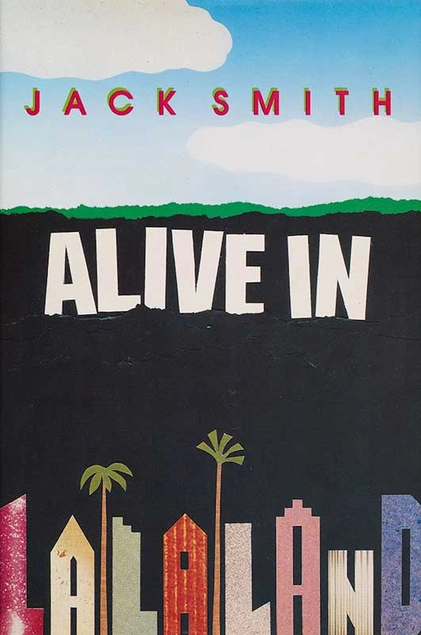
Jack Smith. Alive in La-La Land, New York: Franklin Watts, 1989. Courtesy of a private collector.
In this compilation of columns, Smith gathered pieces that focused on life in Los Angeles. The cover design perfectly evokes his wry, humorous view of his city.
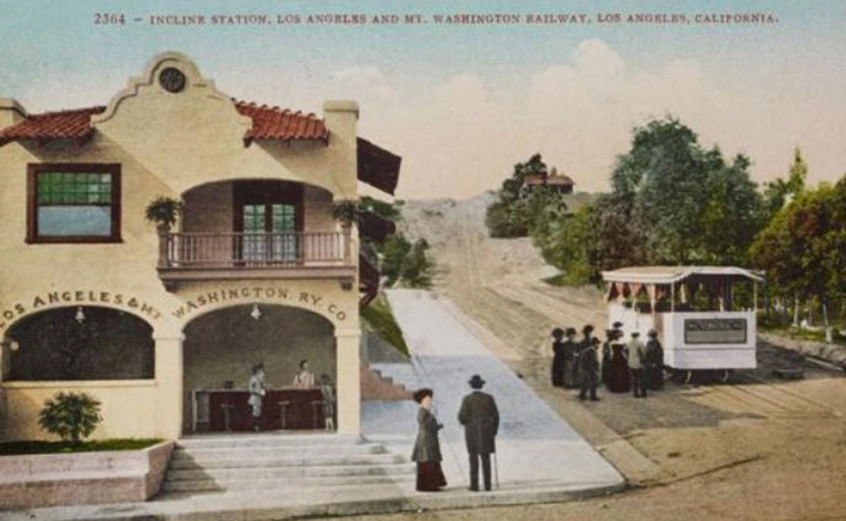
Postcard showing the Los Angeles & Mt. Washington Railway Co. station, ca. 1895.


































Los Angeles Times columnist Jack Smith wrote daily for most of his 42-year career with the paper, producing some 6,000 columns about life in the city. Along the way he became one of the most popular newspaper columnists in Southern California history; reading him was considered a daily "must." He died in January 1996, just a few weeks after the appearance of his last column on Christmas Day, 1995. An exhibition which ran at The Huntington from Feb. 15 to May 12, 2008, looked at Smith the journalist, family man, and social commentator. The Huntington acquired Smith's papers in 2005.
Message from exhibition curator, Sara "Sue" Hodson
A Journalist's Beginnings
Smith was born in Long Beach in 1916 and grew up in Whittier, Bakersfield, and Los Angeles. In his teens, Jack Smith served as editor of the Belmont High Sentinel, later remarking that this was the highest position he ever reached in his career. After leaving Bakersfield Junior College, he began his professional career as a sports editor for the Bakersfield Californian before moving on to the Honolulu Advertiser, where he witnessed the attack on Pearl Harbor in 1941. After the war, Smith covered the infamous story of the Black Dahlia murder for the Los Angeles Daily News. Although some dispute the attribution, Smith probably was the first reporter to publish the sensational name, gleaned from a pharmacist who told him that the victim, Elizabeth Short, was called the "Black Dahlia" for the way she wore her hair.
Smith worked in the heyday of newspapers when it was not uncommon for columnists to settle in for decades. Herb Caen of the San Francisco Chronicle, Mike Royko of the Chicago Daily News, and Jimmy Breslin of New York's Daily News and Newsday personified their cities and newspapers while writing about social life or politics. But as Los Angeles Times writer Robert A. Jones observed in an appreciation of the beloved columnist, Smith lived in a city that was known less for its downtown sidewalks than for its backyards and patios. Smith wrote revealingly about his own comings and goings and in the process managed to carry on intimate conversations with thousands of readers. "The wonderful thing about your writing is that it is so conversational and communicative," wrote reader Joan Miller in 1982. "It almost invariably makes a reader want to respond."
War Correspondent
In World War II, Jack Smith enlisted in the U.S. Marine Corps and was part of the assault on Iwo Jima in February 1945, as a combat correspondent. He went ashore with his rifle, but no typewriter. At a colonel's suggestion, he sent in his typewriter in the colonel's jeep but it was lost when the boat carrying the jeep sank. After another correspondent was killed, Smith acquired the man's typewriter case, which, when pried open, revealed no typewriter but, instead, a supply of canned goods. About this event, Smith wrote, "That's what war is like. Only a thousand times worse." Back home, Jack's wife Denise (Denny), expecting their first child, corresponded with him about ideas for the baby's name, prompting him to pore over a book of baby names. It is unknown whether this book included two names Jack favored: Lucky Jordan Smith (after the title character in the 1942 Alan Ladd film) and Caesar Wolfgang Smith.
The Smith Family
Jack Smith often exploited the activities of his wife, Denny, and sons Curt and Doug to feed the insatiable demands of writing a daily column. He wrote about the latest home remodeling project, the invasions by feral cats living under the porch, and the peccadilloes of the family dog.
One of his most popular columns told the story of an especially prized Christmas present from Denny: pieces of type spelling out a favorite saying, "Spend All Your Kisses." The phrase thereafter reappeared in many more columns over the years.
Mt. Washington
Site of the Smith home, Mt. Washington figured prominently in many columns. Smith explored the history of the neighborhood, as well as its flora and fauna. He became a bird-watcher in his own backyard and in the canyon it over looked. It was there that he famously sighted the common grackle, despite the scoffing of ornithologists. From this historic moment on, the theme of birds, especially the grackle, appeared frequently in his columns, and Jack and Denny became active bird-walk leaders for Descanso Gardens and several area Audubon Societies.
Landmarks of L.A.
As a chronicler of Los Angeles, Smith focused often on its history and landmarks. Whether writing about Clifton's Cafeteria, the Hollywood sign, the Hollywood Hotel, or such constructions as an intricately coiled freeway interchange, Smith delighted in exploring the edifices that give Los Angeles its unique heart and soul, and, in the case of the mighty freeway system, determine much of the cadence of Angelenos' daily lives.
As letters arrived at his desk in the days following a column, Smith would work them into subsequent columns, creating an endless dialogue on language and literature, Hollywood celebrity and sin, and what was perceived to be the strange way of life in La-La Land. “Critics have despised us in Los Angeles as worshippers of money, health, sex, surf, and sun,” Smith once mused. “Not quite true. We don’t worship those things; we just rather get used to them, since they happen to be so available.” He coined the term “the Big Orange” to counter New York’s Big Apple and to evoke a regional identity that outsiders seldom appreciated.
Life in La-La Land
Jack Smith reveled in the sometimes strange way of life in his “left coast” city and in the images it carries for the rest of the world. He embraced all of the insulting names bestowed upon Los Angeles for its easy, tolerant way of life. La-La Land, Double Dubuque, Forty Suburbs in Search of a City, Land of Fruits and Nuts – such epithets tickled Smith and inspired some of his funniest columns, as did the oddities of life in L.A. that inspired these appellations.
The House in Baja
In 1968 Jack and Denny Smith, somewhat to their own surprise, leased a vacation house in Santo Tomas, Baja, built by their landlord Romulo Gomez. For some twenty years, Smith captivated his readers with stories of the incomparable Mr. Gomez and the Baja life of “mañana.”
From the beginning of the relationship, the Smiths had to adjust to Mr. Gomez’s singular approach to construction and maintenance. In a July 8, 1990, column, “Adios to Gomez and Their Baja Mansion,” Smith wrote about the early days of home construction, “Three months later, we drove back to give Gomez some more money and a plan I had drawn. I told him to go ahead. It was another three months before we came back. He was building our house but not on our lot. It was in the middle of the rutted road. I asked him, ‘Gomez, why are you building the house in the middle of the road?’ He said, ‘Because the road has the best view.’ We were to become familiar with that kind of logic.”
From such experiences, Jack Smith wrote his most popular and enduring book, God and Mr. Gomez.
About Words
As one who made his living with words, Jack Smith loved to explore language, the meanings of words, and the minutiae of grammar and usage. Whether debating the proprieties of ending a sentence with a preposition or discovering a fascinating, unfamiliar word like boustrophedon,* Smith and his readers engaged in a lively dialogue about the vagaries of everyday language. Smith eventually collected his columns into nine books of his own, including Smith on Wry, The Big Orange, How to Win a Pullet Surprise, and Alive in La La Land. God and Mr. Gomez.
* Turning like oxen in plowing; an ancient form of writing in which the lines run alternately from left to right and right to left; or the action of some computer printers.
Changing Times
His abiding fascination with the human condition and the way people understand and deal with their world led Jack Smith to explore the changes occurring at ever-escalating rates. Especially in the 1960s and ’70s, decades of enormous social change and unrest, he observed and commented on the widespread shifting mores and values. The U.S. Bureau of the Census grappled with how to designate unmarried heterosexual couples and came up with the acronym "POSSLQ," or "Persons of Opposite Sex Sharing Living Quarters." Smith popularized the term in a series of columns. He also chronicled his own switch from typewriter to computer, sharing his eventual uneasy truce with technology, but also writing about how computers would profoundly and permanently alter people's lives.
Always intellectually curious, Smith watched for the next new idea or invention. In a 1989 column called “Is That All There Is to a Lifetime?” he wrote his own philosophy for life, “The purpose of life is to keep on living and see what happens next.”
Community Involvement
Jack and Denny Smith contributed much to the life of the greater Los Angeles community. An unflagging supporter of public libraries, Jack spoke often to their friends’ groups, seldom turning down an invitation and routinely declining to accept an honorarium. He was also a frequent graduation speaker at area colleges and universities. Denny worked for twenty-six years for the Southern California Counseling Center, and she volunteered with many organizations, including the Los Angeles Assistance League and committees of the Los Angeles Philharmonic. Together, the Smiths worked to promote literacy and children’s education, and his legacy lives on with the Jack and Denny Smith Memorial Fund for Literacy (www.LiteracyLA.org).
Case 1: A Journalist’s Beginnings
Photograph of Jack Smith, ca. 1925.
Whittier YMCA. Photographs of Boys’ Department Wrestling Champs, 1930.
The Belmont Sentinel, Belmont High School, Los Angeles, September 22, 1933.
Photograph of Jack Smith in the newsroom of the Los Angeles Daily News, ca. 1948.
Jack Smith. “The Black Dahlia,” corrected typescript, Jack Smith’s L.A., New York: McGraw-Hill, 1980.
S.S. Monterey. Passenger list, September 1, 1937; and dinner menu, September 4, 1937.
Photograph of Jack Smith, ca. 1935.
Case 2: War Correspondent
Photograph of Jack and Denny Smith, at the Techau Cocktail Lounge, San Francisco, January or February 1945.
Jack Smith. Letter to Anna M. Smith, March 16, 1945.
U.S. Coast Guard. Photograph of Jack Smith and fellow Marines, March, 1945.
Jack Smith. Letter to Denny Smith, August 15, 1945.
Denny Smith. Letter to Jack Smith, November 9, 1945.
Map of Iwo Jima, 1945.
U.S. Department Defense, Fiftieth Anniversary of WWII Commemoration Committee. Bookmark, 1995.
Photograph of Jack and Denny Smith, 1945.
U.S. Marine Corps. Certificate of Honorable and Satisfactory Service for Jack Smith, February 5, 1946.
Case 3: The Smith Family
Photograph of the Smith family at home and at an amusement park, ca. 1949-1950.
Photograph of The Smith family, ca. 1958.
Photograph of Jack Smith and Fleetwood Pugsley, ca. 1980.
Jack Smith. “Dog House May Be Next,” copy of typescript for Spend All Your Kisses, New York: McGraw-Hill, 1978.
Fruit box label, “Airedale: Always a Winner,” facsimile, undated.
Jack Smith. Notecard on Fleetwood Pugsley.
Jack Smith. “Don’t Leave Kisses Unspent,” 1977.
Ward Ritchie. Letter to Jack Smith, January 5, 1978.
Jack Smith. “Spend All Your Kisses,” printed with movable type on linen, undated but after 1977.
Case 4: Mt. Washington
Postcard showing the Los Angeles & Mt. Washington Railway Co. station, ca. 1895.
Howard F. Mason. Letter to Jack Smith, June 24, 1976.
Friends of the UCLA Library. The Mt. Washington Eagle, April 9, 1973.
Jack Smith. “How Many Grackles Does It Take to Be an Expert?” January 16, 1990.
Ethel Averbach. Postcard to Jack Smith, March 19, 1973.
Mary Ellen Pereyra. Notecards depicting the California Common Grackle, presented by the Los Angeles Audubon Society, January 12, 1976.
Kenneth E. Stager. Letter to Jack Smith, November 20, 1970.
Michael LeRoy. Photograph of Jack Smith, ca. 1975.
Case 5: Landmarks of L.A.
Robert Cameron. Photograph from Above Los Angeles, San Francisco: Cameron and Co., 1990.
Jack Smith. Introduction for Above Los Angeles, original typescript, 1990.
Jack Smith. Note cards, undated.
Jack Smith. Notebook, undated.
Jack Smith. “L.A. Landmarks: Then, Now and . . . Tomorrow?” August 8, 1990.
Views of Clifton’s, promotional booklet, 1956; and postcard depicting Clifton’s Cafeteria, undated.
Hollywood Hotel brochure, undated.
Francis J. Weber. Hollywood, San Fernando: Junipero Serra Press, 1981.
Robert Lawrence Balzer. Letter to Jack Smith, December 26, 1974.
Case 6: Life in La-La Land
Jack Smith. Note card, undated.
La La Land address labels for Jack and Denny Smith.
Jack Smith. Alive in La-La Land, New York: Franklin Watts, 1989.
Herb Caen. Letter to Jack Smith, April 5, 1977.
Jack Smith. “The Great Air Raid,” corrected typescript from Jack Smith’s L.A., New York: McGraw-Hill, 1980.
Alan Napier. Letter to Jack Smith, after April 8, 1975.
Mason Mallory. Los Angeles, musical score, inscribed to Jack Smith, copyright 1967.
Jack Smith. “So Much Hot Air,” clipping from Los Angeles Times Magazine, with a note to Smith from Byron Marshall, January 11, 1987.
Steve Brown. The Big Orange, reproduction, 1976.
Sheila Ruth. I’ll Take L.A. Over New York, reproduction, undated.
Case 7: The House in Baja
Romulo Gomez Monroy. Home for the Smith family in Bocana de Santo Tomas, Baja, California, Mexico, December 4, 1968. List of expenditures.
Photograph of the Smith house in Santo Tomas, Baja, ca. 1970.
Jack Smith. Card containing notes for the introduction to God and Mr. Gomez, 1974.
Photograph of Romulo Gomez and Jack Smith working on the house, ca. 1970.
Jack Smith. Baja Logbook, 1970-1977.
Jack Smith’s Greek fisherman’s hat.
Photograph of Jack Smith at a book signing for God and Mr. Gomez, 1974.
Jack Smith. “Baja Home in the Hands of God, Gomez,” November 24, 1988.
Steve Schapiro. Photograph of Jack Smith, with Baja house in background, ca. 1975.
Case 8: About Words
Grant Campbell. Words: A Potpourri of Fascinating Origins, Santa Barbara: Capra Press, 1992.
Jack Smith. Notebook, undated.
Jack Smith. “God Bless Profanity,” corrected typescript, undated.
Al Hudson. Letter to Jack Smith, March 8, 1982.
Robert M. W. Vogel. Letter to Jack Smith, July 12, 1982.
Charlton Heston. Letter to Jack Smith, March 22, 1988.
Photograph of Jack Smith, ca. 1980.
Case 9: Changing Times
Jack Smith. “Global Skepticism,” clipping from the Los Angeles Times Magazine, November 15, 1987.
Thomas R. Egan. Letter to Jack Smith, February 1, 1988.
Jack Smith. Note card, undated.
International Flat Earth Society of America. Card awarding Jack Smith an honorary membership, undated.
James E. Wade. Letter to Jack Smith, July 10, 1980.
George H. Plagens. Letter to Jack Smith, July 10, 1980.
John Abraham. Letter to Jack Smith, January 30, 1979.
Jack Smith. “Article. Diction,” computer printout, May 1, 1985.
Jack Smith. Floppy disks and a miniature data cartridge.
Flat Earth Research Society International. The Flat Earth Map: Real World, inscribed to Jack Smith by Charles K. Johnson, president, February 22, 1988.
Case 10: Community Involvement
Robert Newman. Letter to Jack Smith, July 10, 1980.
Photograph of Jack Smith speaking to the Friends of the Los Alamitos Public Library, early July, 1980.
Chuck Bernstein. Letter to Jack Smith, November 6, 1971.
Jack Smith. Commencement address for Occidental College, corrected typescript, June 9, 1979.
Craig Dietz. Photograph of Jack Smith with Occidental College president Richard C. Gilman, June 9, 1979.
Jack Smith. Untitled speech about volunteerism, corrected typescript, undated.
Photograph of Jack Smith reading to elementary school children, 1991.
Mikio Kimoto. Artist’s rendering of the Jack and Denny Smith Library and Community Center, Mount Washington Elementary School.
County of Los Angeles, Board of Supervisors. Proclamation recognizing the dedication of the Jack and Denny Smith Library and Community Center, April 16, 2004.
Photograph of Jack and Denny Smith, at the Historical Society of Southern California, ca. 1990.
In the Foyer (Exhibition Entrance)
Photograph of Jack Smith with Jayne Mansfield and two unidentified men, ca. 1960.
Bruce Cox, for the Los Angeles Times. Photograph of Jack Smith with runner Marsh Greenwood at the Downtown YMCA, before February 22, 1963.
Los Angeles Times. Photograph of Jack Smith, probably in 1964.
Los Angeles Daily News. Photograph of Jack Smith and other reporters at the Stompanato murder trial involving Lana Turner’s daughter, 1958.
John Gaines, for the Los Angeles Times. Photograph of Jack Smith, March 10, 1965.
Amanda Blanco. Photograph of Jack Smith, ca.1980.
This exhibition was made possible by the Robert F. Erburu Exhibition Endowment Fund
Special Thanks to Alison P. Smith, Curtis B. Smith, and Douglas F. Smith